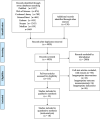Clinical Reference Strategy for the Selection of Treatment Materials for Maxillofacial Bone Transplantation: A Systematic Review and Network Meta-Analysis
- PMID: 35532735
- PMCID: PMC9130380
- DOI: 10.1007/s13770-022-00445-5
Clinical Reference Strategy for the Selection of Treatment Materials for Maxillofacial Bone Transplantation: A Systematic Review and Network Meta-Analysis
Abstract
Bone graft materials have mixed effects of bone repair in the field of oral maxillofacial surgery. The qualitative analyses performed by previous studies imply that autogenous odontogenic materials and autogenous bone have similar effects on bone repair in clinical jaw bone transplantation. This retrospective systematic assessment and network meta-analysis aimed to analyze the best effect of clinical application of autogenous odontogenic materials and autogenous, allogeneic, and xenogeneic bone grafts in bone defect repair. A systematic review was performed by searching the PubMed, Cochrane Library, and other journal databases using selected keywords and Medical Subject Headings search terms. 10 Papers (n = 466) that met the inclusion criteria were selected. The assessment of heterogeneity did not reveal any overall statistical difference or heterogeneity (P = 0.051 > 0.05), whereas the comparison between autogenous and allogeneic bone grafts revealed local heterogeneity (P = 0.071 < 0.1). Risk of bias revealed nine unclear studies and one high-risk study. The overall consistency was good (P = 0.065 > 0.05), and the local inconsistency test did not reveal any inconsistency. The publication bias was good. The confidence regarding the ranking of bone graft materials after GRADE classification was moderate. The effects on bone repair in the descending order were as follows: autogenous odontogenic materials, xenogeneic bone, autogenous bone, and allogeneic bone. This result indicates that the autogenous odontogenic materials displayed stronger effects on bone repair compared to other bone graft materials. Autogenous odontogenic materials have broad development prospects in oral maxillofacial surgery.
Keywords: Allogeneic bone; Autogenous bone; Autogenous tooth; Network meta-analysis; Xenogeneic bone.
© 2022. Korean Tissue Engineering and Regenerative Medicine Society.
Conflict of interest statement
We declare no financial or personal relationships with other people or organizations that can inappropriately influence our work.
Figures











Similar articles
-
Systemic pharmacological treatments for chronic plaque psoriasis: a network meta-analysis.Cochrane Database Syst Rev. 2017 Dec 22;12(12):CD011535. doi: 10.1002/14651858.CD011535.pub2. Cochrane Database Syst Rev. 2017. Update in: Cochrane Database Syst Rev. 2020 Jan 9;1:CD011535. doi: 10.1002/14651858.CD011535.pub3. PMID: 29271481 Free PMC article. Updated.
-
Drugs for preventing postoperative nausea and vomiting in adults after general anaesthesia: a network meta-analysis.Cochrane Database Syst Rev. 2020 Oct 19;10(10):CD012859. doi: 10.1002/14651858.CD012859.pub2. Cochrane Database Syst Rev. 2020. PMID: 33075160 Free PMC article.
-
Systemic pharmacological treatments for chronic plaque psoriasis: a network meta-analysis.Cochrane Database Syst Rev. 2021 Apr 19;4(4):CD011535. doi: 10.1002/14651858.CD011535.pub4. Cochrane Database Syst Rev. 2021. Update in: Cochrane Database Syst Rev. 2022 May 23;5:CD011535. doi: 10.1002/14651858.CD011535.pub5. PMID: 33871055 Free PMC article. Updated.
-
Surgical interventions for treating extracapsular hip fractures in older adults: a network meta-analysis.Cochrane Database Syst Rev. 2022 Feb 10;2(2):CD013405. doi: 10.1002/14651858.CD013405.pub2. Cochrane Database Syst Rev. 2022. PMID: 35142366 Free PMC article.
-
Effect of maxillary sinus augmentation on the survival of endosseous dental implants. A systematic review.Ann Periodontol. 2003 Dec;8(1):328-43. doi: 10.1902/annals.2003.8.1.328. Ann Periodontol. 2003. PMID: 14971260
Cited by
-
The histological and radiological evaluation of autologous peripheral venous blood concentrates in socket preservation: a systematic review and meta-analysis.Front Dent Med. 2025 Jul 11;6:1602738. doi: 10.3389/fdmed.2025.1602738. eCollection 2025. Front Dent Med. 2025. PMID: 40718018 Free PMC article.
-
A multi-dimensional performance evaluation of large language models in dental implantology: comparison of ChatGPT, DeepSeek, Grok, Gemini and Qwen across diverse clinical scenarios.BMC Oral Health. 2025 Jul 28;25(1):1272. doi: 10.1186/s12903-025-06619-6. BMC Oral Health. 2025. PMID: 40721763 Free PMC article.
-
Insulin promotes the bone formation capability of human dental pulp stem cells through attenuating the IIS/PI3K/AKT/mTOR pathway axis.Stem Cell Res Ther. 2024 Jul 29;15(1):227. doi: 10.1186/s13287-024-03843-9. Stem Cell Res Ther. 2024. PMID: 39075596 Free PMC article.
-
Regeneration of Rabbit Calvarial Defects with Combination of Stem Cells and Enamel Matrix Derivative: A Microcomputed Tomography and Histological Evaluation Comparing Two- and Three-Dimensional Cell Constructs.Medicina (Kaunas). 2024 Mar 8;60(3):451. doi: 10.3390/medicina60030451. Medicina (Kaunas). 2024. PMID: 38541178 Free PMC article.
References
Publication types
MeSH terms
LinkOut - more resources
Full Text Sources
Medical
Miscellaneous
